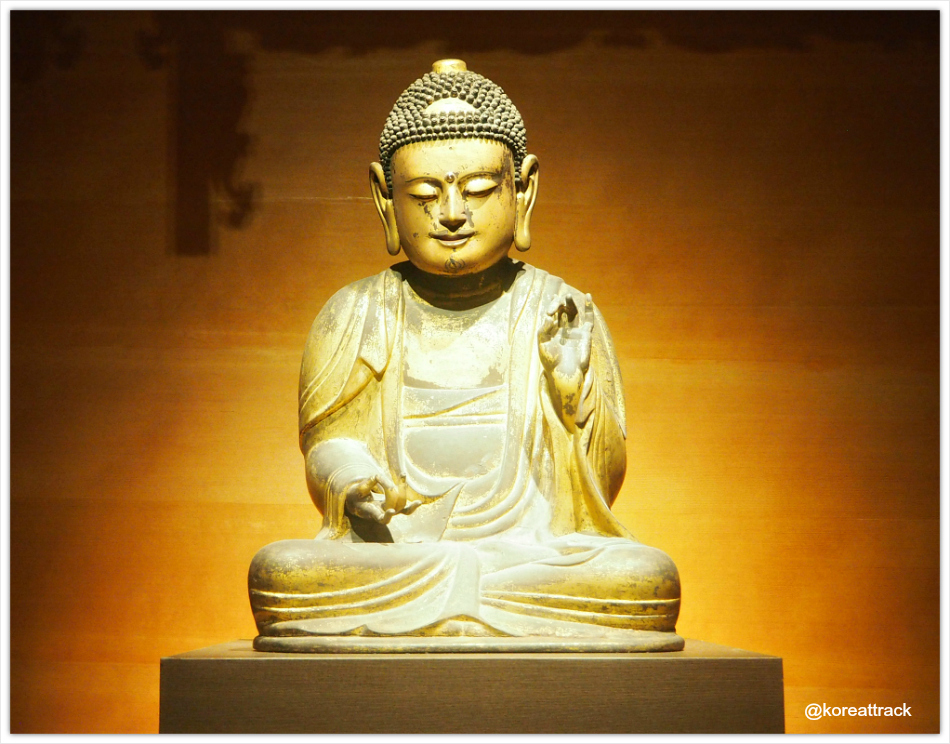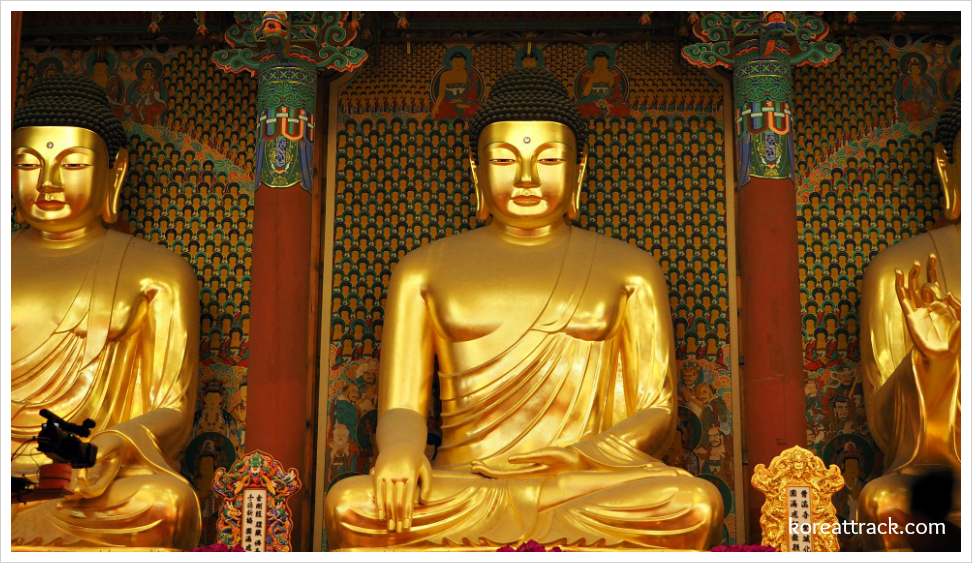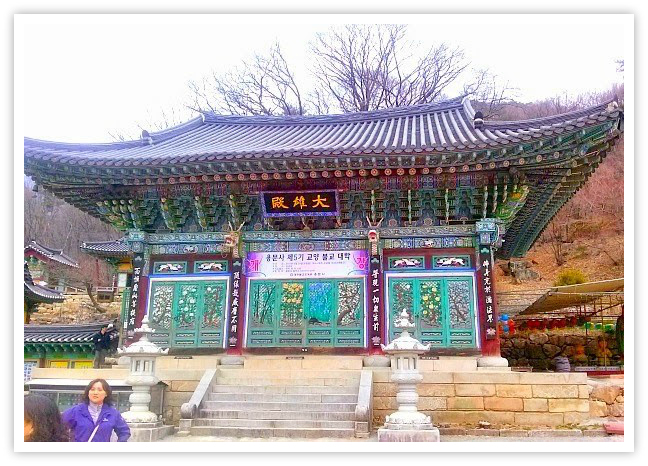Mystical Donghwasa Temple
In Daegu City
 Donghwasa Temple in Daegu - Daeungjeon (Main Dharma Hall)
Donghwasa Temple in Daegu - Daeungjeon (Main Dharma Hall)Donghwasa Temple in Daegu
Donghwasa Temple in Daegu City, South Korea, is a must-visit destination for those who love history, spirituality, and nature.
It is situated on the southern side of Mt. Palgongsan, and its serene atmosphere provides a perfect escape from the city's hustle and bustle.
With its rich history, stunning natural surroundings, and unique architecture, Donghwasa Temple offers visitors an unforgettable experience.
The Name and Its Meaning
 Donghwasa Temple in Daegu - Four Guardians Gate
Donghwasa Temple in Daegu - Four Guardians GateDonghwasa, also commonly referred to as Donghwa Temple, is a sacred place in South Korea that derives its name from the magnificent Paulownia Blossoms that bloom in the area.
According to an old legend, these flowers were believed to bloom throughout the year, even in the harsh winter months, symbolizing good fortune and perseverance.
This temple is considered a cultural treasure and attracts visitors from far and wide who admire its beauty and learn about its history.
Historical Origins
Donghwasa Temple, a prominent Buddhist temple located south of Daegu, South Korea, has a rich history dating back to the 5th century.
Venerable Geukdal originally founded the temple as Yugasa Temple in 493 CE. However, in 832 CE, when Patriarch Venerable Simji came into power, it changed its name to Donghwasa.
According to legend, Patriarch Venerable Simji enshrined bones with sutras engraved in a small well north of the current Chamdang Hall.
This act led to the establishment of Donghwasa Temple, which has since become one of the most popular tourist destinations in South Korea.
The temple is renowned for its architectural beauty, including the iconic Bell Pavilion and its serene natural surroundings. Visitors can explore the temple's many halls and pagodas, participate in meditation sessions, and enjoy stunning views of the surrounding mountains.
Architectural Highlights
The temple's Main Hall, known as Daeungjeon, is an impressive structure that serves as the heart of the temple.
It is a spacious hall adorned with intricate carvings and paintings depicting Buddhist teachings and symbols. Devotees gather in the hall for prayers and ceremonies, seeking spiritual guidance and enlightenment.
The Bell Pavilion is a serene space located within the temple grounds. It houses a large bell used for rituals, which visitors can ring to purify their minds and seek inner peace.
The pavilion's peaceful surroundings and the harmonious sound of the bell make it a popular spot for meditation and introspection.
Biroam Hermitage is another must-visit attraction within the temple complex. Here, visitors can marvel at the Three-Story Stone Pagoda, an ancient relic dating back to the late 9th century.
This pagoda is a remarkable example of the Silla dynasty's architectural style, featuring intricate carvings and decorations depicting Buddhist teachings.
 The bell and drum pavilion at Donghwasa Temple
The bell and drum pavilion at Donghwasa TempleThe Stone Vairocana Buddha is another ancient relic that visitors can admire within the temple complex.
This intricately designed statue was also built during the 9th century and showcases the region's artistic heritage. It is a significant cultural and historical artifact with immense religious and cultural significance for devotees and visitors alike.
 Buddha stone sculpture at Donghwasa Temple
Buddha stone sculpture at Donghwasa TempleThe Giant Buddha Statue
The Donghwasa temple boasts a grand bronze Buddha statue that stands approximately 17 meters tall.
As you approach the statue, you can't help but marvel at its intricate details, which are nothing short of awe-inspiring.
The statue's serene presence fills you with a sense of calm and peace, making it the highlight of the temple. This exceptional statue symbolizes enlightenment and compassion, and it's no surprise that it attracts numerous visitors to this tranquil sanctuary.
Dragons, Lanterns, and Hidden Sanctuaries
 A Four-storey Stone Pagoda on the grounds of Donghwasa Temple in Daegu
A Four-storey Stone Pagoda on the grounds of Donghwasa Temple in DaeguAs you walk up the staircases of the temple, you'll notice that they are lined with intricately designed dragons. These mythical creatures are believed to add a mystical touch to the temple and are often regarded as protectors of the sacred space.
Beyond the staircases, the temple grounds are graced by a few large stone lanterns. These lanterns are not just decorative but also serve as symbols of enlightenment and wisdom in Buddhist culture.
Interestingly, during the Joseon Dynasty, Buddhism faced persecution, and Donghwasa served as a hidden sanctuary for monks seeking refuge in remote mountain temples.
These hidden sanctuaries are said to have been crucial for the survival of Buddhism in Korea and played a vital role in preserving the religion's teachings and traditions.
Temple Stay and YaksaYeoraeDaebul
The YaksaYeoraeDaebul, a colossal stone statue at the peak of Donghwasa, offers an extraordinary opportunity for those seeking a serene and holy space to meditate and contemplate.
The statue is accessible around the clock, providing a tranquil and sacred environment for individuals to engage in spiritual practices and introspection.
The temple also offers a unique Templestay Program, allowing visitors to immerse themselves in temple life and experience the daily routines and rituals of the resident monks.
Donghwasa Temple invites you to explore its rich heritage, immerse yourself in tranquility, and witness the timeless beauty of Korean Buddhism. 🙏✨
For more information, you can visit the official .
Getting to Donghwasa Temple in Daegu
Let's explore how to reach the enchanting Donghwasa Temple from Seoul and Daegu City.
From Seoul to Donghwasa Temple:
By Train and Bus
To get to Donghwasa Temple in Seoul, take a KTX (Korea Train Express) or Korail Mugunghwa train to Dongdaegu Railroad Station. After exiting the station, head to the bus stop beside parking lot No. 3.
Look for express bus no. 1, which runs approximately every 12 minutes. Take the bus and get off at the Donghwasa Temple entrance, the second-to-last stop. Once you get off the bus, it's just a pleasant 7-8 minute walk to the temple.
By Car
If you prefer driving, take your car from Seoul to Donghwasa. The distance is approximately 300 kilometers, and the drive takes around 3.5 to 4 hours, depending on traffic and road conditions.
From Daegu City to Donghwasa Temple
From Dongdaegu Railroad Station
To get to Donghwasa Temple from Dongdaegu Station, use the exit located next to Parking Lot No. 3. Once you're out, head to the bus stop next to the exit.
From there, take Express Bus No. 1, which arrives approximately every 12 minutes. Get off at Donghwasa Temple entrance, which is the second-to-last stop. Then, walk for about 7-8 minutes to reach the temple.
From Daegu Station (Daegu Subway)
Take either city bus 105 or 131 from Exit 3 of Daegu Station to Donghwasa Temple. Alternatively, get off at Donghwasa Mass Facility Area and walk to the temple. Total travel time is approximately 1 hour.
Address: 1 Donghwasa 1-gil, Dong-gu, Daegu
Remember to immerse yourself in the rich heritage, explore the architectural marvels, and bask in the tranquility of this sacred place. Safe travels! 🙏✨
Sources:
- http://donghwasa.net/
- https://bing.com/search?q=Donghwasa+Temple+Daegu+features
- https://en.wikipedia.org/wiki/Donghwasa
- https://www.frommers.com/destinations/daegu/attractions/donghwasa-donghwa-temple
- Home
- Temples in South Korea
- Donghwasa Temple In Daegu
Get Exciting Activities
Book one of our exciting activities today to experience the thrill of a lifetime! Take advantage of this opportunity and secure your spot in advance.
Hotel Map Guide
Find your affordable, accessible, and comfortable hotel in Seoul at Agoda.Com. See the hotel map below...
Hotel Booking Guide
Find affordable and amazing hotels on Agoda.com using the search box below. Book now to enjoy great discounts and save!







New! Comments
What do you think about this page? Leave me a comment in the box below.